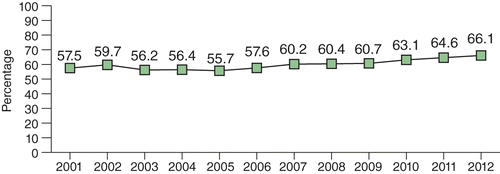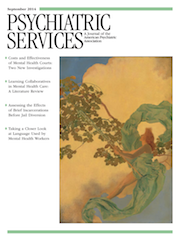Datapoints: Follow-Up Encounters Within 30 Days of a Substance Abuse–Related Inpatient Discharge
Outpatient treatment for substance use disorders promotes recovery and reduces readmission (1,2). We measured the annual percentage of individuals aged 13–64 who were covered under employer health plans and who received outpatient treatment for a substance use disorder within 30 days of a related inpatient stay.
All data (2001–2012) were from the Truven Health MarketScan Commercial Claims and Encounters Database, which includes claims of employed individuals and dependents from all U.S. Census divisions. Data were weighted to be nationally representative of individuals with employer-sponsored insurance, 48% of the U.S. population in 2012 (3). The denominator was number of claims that met these criteria: discharge from an inpatient acute or residential facility, age 13–64, primary ICD-9-CM discharge diagnosis of drug or alcohol abuse or dependence, discharge date between January 1 and December 1 (to allow for 30 days of December follow-up), discharge status was not death or transfer to another facility, and continued plan enrollment for 30 days after discharge. The numerator was number of denominator stays for which there was an outpatient visit related to a substance use disorder within 30 days, defined by a primary ICD-9-CM diagnosis or code pertaining to mental health or substance abuse. We captured both types of diagnoses because substance use disorders are often recorded as mental disorders.
Since 2003 the rate at which individuals have received outpatient treatment for a substance use disorder within 30 days of a related inpatient stay has alternated between plateaus and periods of increase (Figure 1). The rate has grown at least a little every year since 2005, reaching 66.1% in 2012.

A single measure in the Healthcare Effectiveness Data and Information Set (HEDIS) tracks the rate of outpatient follow-up within seven or 30 days of an inpatient psychiatric discharge. There is no exact analog for substance use disorders. The most similar HEDIS measure, “engagement” in substance use disorder treatment, requires two outpatient visits related to a substance use disorder within 30 days of “initiation,” which does not require a hospital stay. The dissimilarity of the two follow-up measures makes it difficult to compare outcomes for persons with substance use disorders and those with other mental disorders. A 30-day follow-up measure for substance use disorders would promote care delivery, research, policy making, and advocacy. The figure presented here represents a first step toward that goal.
1 : Substance abuse intensive outpatient programs: assessing the evidence. Psychiatric Services 65:718–726, 2014Link, Google Scholar
2 : How effective is continuing care for substance use disorders? A meta-analytic review. Journal of Substance Abuse Treatment 46:87–97, 2014Crossref, Medline, Google Scholar
3 Health Insurance Coverage of the Total Population. Menlo Park, Calif, Kaiser Family Foundation. Available at kff.org/other/state-indicator/total-population. Accessed April 22, 2014Google Scholar



